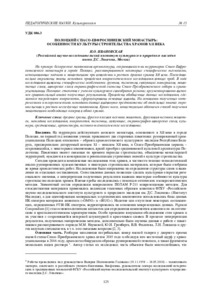Please use this identifier to cite or link to this item:
https://elib.psu.by/handle/123456789/22983| Title: | Полоцкий Спасо-Евфросиниевский монастырь: особенности культуры строительства храмов XII века |
| Authors: | Ивановская, И. О. |
| Issue Date: | 2018 |
| Publisher: | Полоцкий государственный университет |
| Citation: | Вестник Полоцкого государственного университета. Серия E, Педагогические науки. - 2018. - № 15. - С. 125-130. |
| Abstract: | На примере белорусских памятников архитектуры, сохранившихся на территории Спасо-Евфросиниевского монастыря в городе Полоцке, рассматриваются некоторые специфические технологии, использованные зодчими и живописцами при возведении и росписи древних храмов XII века. Последовательно отражены этапы методики проведения микроскопического исследования взятых проб. В ходе исследования выявлены специфические особенности грунтов, пигментов, связующих материалов, живописных слоев, авторских слоев стратиграфической системы Спасо-Преображенского собора и храма-усыпальницы Полоцких епископов с учетом культурного своеобразия региона; аргументированно выполнен сравнительный анализ полученных результатов. Приведены обобщенные данные исследования, сделанного посредством микроскопии, сформулированы основные выводы. На основании полученных эмпирическими и теоретическими методами данных выдвинуто предположение об отдельных этапах строительства и росписи исследуемых памятников. Кроме того, концептуально обозначен способ получения живописцами необходимых колеров в обоих храмах.= The article discusses some buildings and art technologies. These technologies were used by builders and artists in the construction and painting of ancient temples. Such temples were built on the territory of the Spaso-Evfrosinievsky monastery in Polotsk. The article consistently and in detail reflects the steps of the microscopic examination technique. The specific features of soils, pigments, painting layers, author layers of the stratigraphic system of the Transfiguration Church and the tomb-temple of the Polotsk bishops were discovered during the study. In interpreting the results, the cultural identity of the region was taken into account. The comparative analysis of the results was based on the important arguments. The paper presents the generalized materials of the detailed study done by microscopy. The author formulates the concise conclusions on the topic. All data were obtained by empirical and theoretical methods. Based on the data obtained, we made an assumption about the stages of construction and painting of the investigated monuments. In addition, a concept has been proposed. It describes the method for painters to obtain the necessary color schemes in the both temples. |
| Keywords: | Педагогика Государственный рубрикатор НТИ - ВИНИТИ::ОБЩЕСТВЕННЫЕ НАУКИ::Народное образование. Педагогика Древние храмы Фреско-клеевая техника живописи Фресковая техника живописи Методика исследования Микроскопия Пигменты Связующие Стратиграфия авторских слоев Культура Средневековье Архитектура Технико-технологическое исследование Ancient temples of the Savior-Evfrosynie monastery Fresco-glue painting technique Fresco painting technique Research methods Microscopy Pigments Binders Stratigraphy of copyright layers Culture Middle ages Architecture |
| URI: | https://elib.psu.by/handle/123456789/22983 |
| metadata.dc.rights: | open access |
| Appears in Collections: | 2018, № 15 |
Files in This Item:
| File | Description | Size | Format | |
|---|---|---|---|---|
| 125-130.pdf | 213.33 kB | Adobe PDF |  View/Open |
Items in DSpace are protected by copyright, with all rights reserved, unless otherwise indicated.